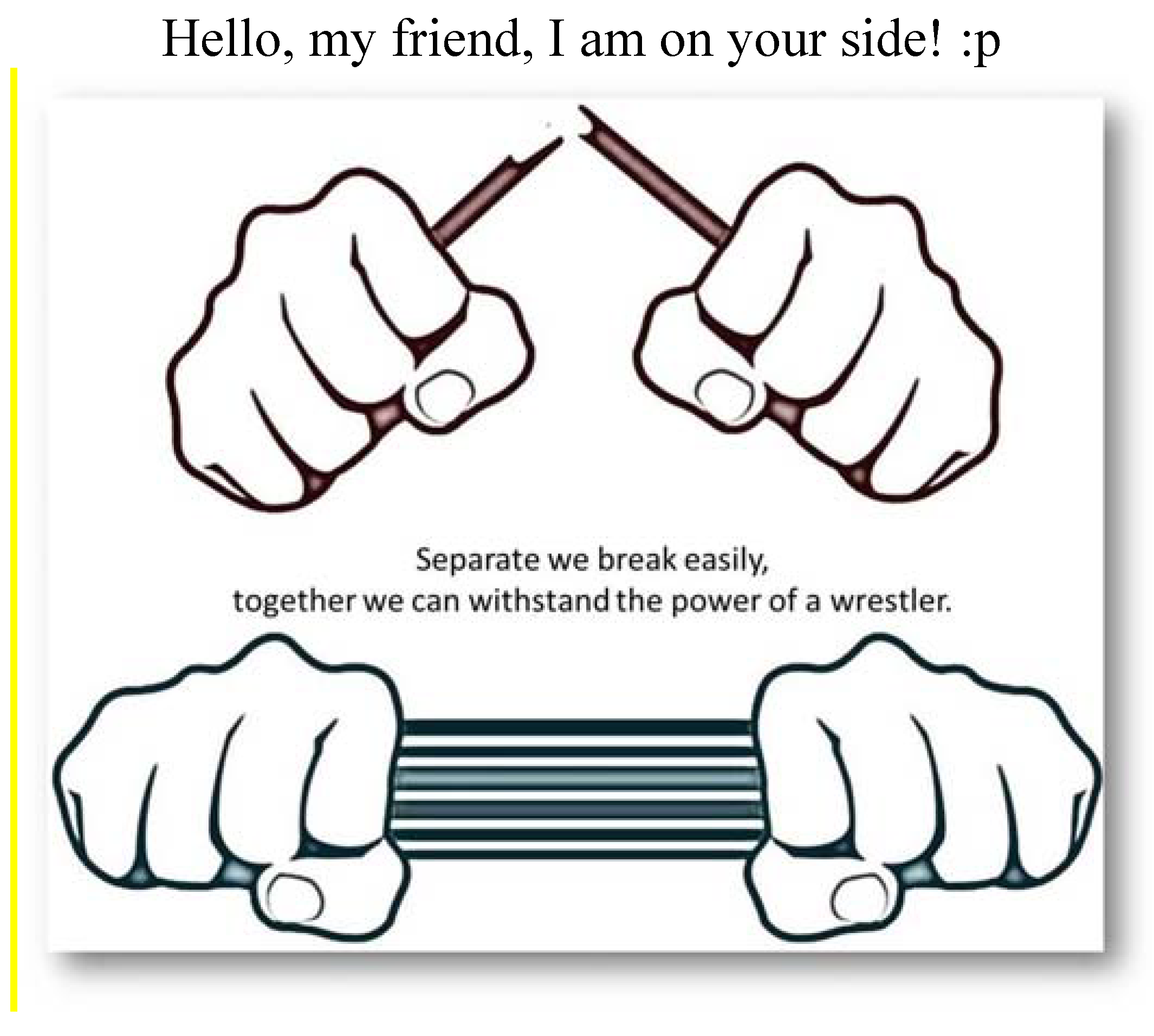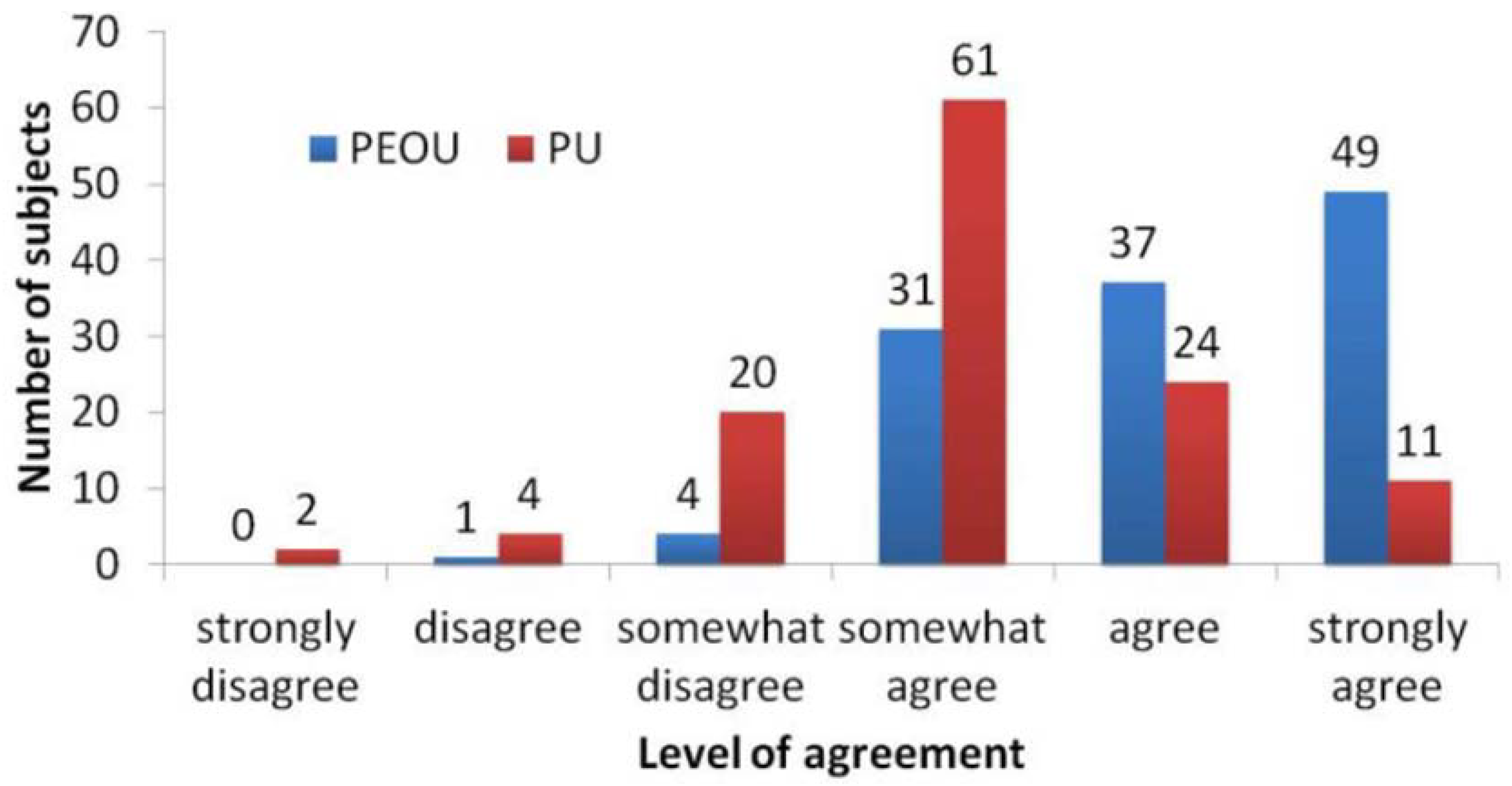Promoting Positive Psychology Using Social Networking Sites: A Study of New College Entrants on Facebook
Abstract
:1. Introduction
1.1. Social Networks in College
1.2. Objectives
2. Experimental Section
2.1. Population and Procedure
2.2. Study Design

2.3. Data Collection and Analysis
- Social Influence (SocI): the numbers of Likes on other posters’ comments to each message.
- Individual Engagement (IndE): the numbers of Likes and Comments on each message. This metric has three levels: 1 = above 41; 2 = between 32 and 41; 3 = below 32.
- Message content type (cType): 1 = emotional, 2 = cognitive.
- Message presentation mode (pMode): 1 = graphic with directive short messages; 2 = graphic with motivational short messages; 3 = graphic or motion picture with long messages.
3. Results and Discussion
3.1. Results
3.1.1. Initial Survey
3.1.2. Message Responses
| cType | N | Likes | Comments | Likes on Comments |
|---|---|---|---|---|
| emotional | 20 | 661 (352/309) | 92 (40/52) | 165 (107/58) |
| cognitive | 18 | 559 (308/251) | 64 (45/19) | 92 (67/25) |
| Total | 38 | 1,220 (660/560) | 156 (85/71) | 257 (174/83) |
| pMode | N | Likes | Comments | Likes on Comments |
|---|---|---|---|---|
| 1 | 17 | 566 (295/271) | 88 (39/49) | 146 (98/48) |
| 2 | 7 | 219 (123/96) | 14 (14/0) | 37 (37/0) |
| 3 | 14 | 435 (242/193) | 54 (32/22) | 74 (39/35) |
| Total | 38 | 1,220 (660/560) | 156 (85/71) | 257 (174/83) |
| Interval (week) | Likes | Comments | Likes on Comments | |||
|---|---|---|---|---|---|---|
| Medical school | Management school | Medical school | Management school | Medical school | Management school | |
| 1–12 | 17.37 | 14.61 | 2.24 | 1.87 | 4.58 | 2.18 |
| 1–3 | 18.09 | 17.90 | 2.91 | 4.12 | 6.55 | 3.91 |
| 4–6 | 16.22 | 14.78 | 1.56 | 1.77 | 5.56 | 3.67 |
| 7–9 | 19.00 | 12.38 | 2.13 | 1.25 | 2.38 | 0.88 |
| 10–12 | 16.30 | 12.60 | 2.20 | 0.00 | 3.30 | 0.00 |
| Variable | Medical School | Management School | ||||||||||
|---|---|---|---|---|---|---|---|---|---|---|---|---|
| Likes | Comments | Likes on Comments | Likes | Comments | Likes on Comments | |||||||
| F | P | F | P | F | P | F | P | F | P | F | P | |
| Interval | 0.383 | 0.766 | 1.185 | 0.330 | 1.175 | 0.333 | 5.632 | 0.003 ** | 2.167 | 0.100 * | 1.717 | 0.181 |
| cType | 0.063 | 0.803 | 0.421 | 0.520 | 0.486 | 0.490 | 1.130 | 0.294 | 1.012 | 0.321 | 0.613 | 0.438 |
| pMode | 0.005 | 0.994 | 0.041 | 0.959 | 0.699 | 0.503 | 1.182 | 0.318 | 0.964 | 0.391 | 0.584 | 0.562 |
3.1.3. Acceptance Test

| Construct | Mean | SD | Range | PEOU | PU | Intension to Use |
|---|---|---|---|---|---|---|
| PEOU | 5.05 | 0.93 | 2 to 6 | 1.000 | ||
| PU | 5.48 | 0.85 | 1 to 6 | 0.413 ** | 1.000 | |
| Intention to use | 5.37 | 0.94 | 1 to 6 | 0.227 * | .675 ** | 1.000 |
3.2. Discussion
3.2.1. Message Responses
3.2.2. Acceptance Test
3.2.3. Limitation
4. Conclusions
Acknowledgments
Author Contributions
Conflicts of Interest
References
- Why Positive Psychology Is Necessary. Available online: http://web.missouri.edu/~sheldonk/pdfarticles/AP01.pdf (accessed on 13 June 2005).
- Positive Psychology: An Introduction. Available online: http://www.ppc.sas.upenn.edu/ppintroarticle.pdf (accessed on 28 February 2014).
- Positive Psychology: Past, Present, And (Possible) Future. Available online: http://personalpages.manchester.ac.uk/staff/alex.wood/positive.pdf (accessed on 28 February 2014).
- Positive Psychology, Positive Prevention, and Positive Therapy. Available online: http://homepage.psy.utexas.edu/HomePage/Class/Psy418/Josephs/Wynne%20Folder/1-Positive%20Psychology.pdf (accessed on 28 February 2014).
- Social Media and the Health System. Available online: http://www.ncbi.nlm.nih.gov/pmc/articles/PMC3048641/pdf/i1552-5775-15-1-71.pdf (accessed on 28 February 2014).
- Developing Health Promotion Interventions on Social Networking Sites: Recommendations from the FaceSpace Project. Available online: http://www.ncbi.nlm.nih.gov/pmc/articles/PMC3374544/?report=printable (accessed on 28 February 2014).
- Gable, S.L.; Haidt, J. What (and why) is positive psychology? Rev. Gen. Psychol. 2005, 9, 103–110. [Google Scholar]
- Selvam, S.G. Positive Psychology as a theoretical framework for studying and learning about religion from the perspective of psychology. In Presented at the BSA Sociology of Religion Study Group—Teaching and Studying Religion Symposium, London, UK; 2011. [Google Scholar]
- Kauffman, C. Positive Psychology: The Science at the Heart of Coaching. In Evidence Based Coaching Handbook: Putting Best Practices to Work for Your Clients; Stober, D.R., Grant, A.M., Eds.; Wiley: New York, NY, USA, 2006; pp. 219–253. [Google Scholar]
- Social Influence as a Driver of Engagement in a Web-Based Health Intervention. Available online: http://www.jmir.org/2012/1/e36/ (accessed on 28 February 2014).
- Peterson, C.; Seligman, M.E. Character Strengths and Virtues: A Handbook and Classification—2004 Publication; Oxford University Press: Oxford, UK, 2004. [Google Scholar]
- Compliance, Identification, and Internalization: Three Processes of Attitude Change. Available online: http://scholar.harvard.edu/hckelman/files/Compliance_identification_and_internalization.pdf (accessed on 28 February 2014).
- A Review of Facebook Research in the Social Sciences. Available online: http://pps.sagepub.com/content/7/3/203.short (accessed on 28 February 2014).
- Blended Learning Environments: Using Social Networking Sites to Enhance the First Year Experience. Available online: http://www.ascilite.org.au/conferences/auckland09/procs/mccarthy.pdf (accessed on 28 February 2014).
- Happier Together: Integrating a Wellness Application into a Social Network Site. Available online: http://misc.si.umich.edu/publications/3 (accessed on 28 February 2014).
- The Impact of Personality on Depression among University Students in Taiwan. Available online: http://www.ncbi.nlm.nih.gov/pubmed/22035898 (accessed on 28 February 2014).
- Facebook Psychology: Popular Questions Answered By Research. Available online: http://www.apa.org/pubs/journals/features/ppm-1-1-23.pdf (accessed on 28 February 2014).
- College Students’ Social Networking Experiences On Facebook. Available online: http://www.sciencedirect.com/science/article/pii/S0193397308001408 (accessed on 28 February 2014).
- The Benefits of Facebook “Friends:” Social Capital and College Students’ Use of Online Social Network Sites. Available online: http://onlinelibrary.wiley.com/doi/10.1111/j.1083-6101.2007.00367.x/full (accessed on 28 February 2014).
- “Likes” Are Lovely, But Do They Lead To More Logins? Developing Metrics for Academic Libraries’ Facebook Pages. Available online: http://crln.acrl.org/content/73/1/18.full (accessed on 28 February 2014).
- A Case Study of Israeli Higher-Education Institutes Sharing Scholarly Information with the Community Via Social Networks. Available online: http://www.sciencedirect.com/science/article/pii/S1096751611000534 (accessed on 28 February 2014).
- From High School to University: Impact of Social Networking Sites on Social Capital in the Transitions of Emerging Adults. Available online: http://onlinelibrary.wiley.com/doi/10.1111/bjet.12026/abstract (accessed on 28 February 2014).
- Davis, F.D. Perceived usefulness, perceived ease of use, and user acceptance of information technology. MIS Q. 1989, 3, 319–340. [Google Scholar] [CrossRef]
- Junco, R. The relationship between frequency of Facebook use, participation in Facebook activities, and student engagement. Comput. Educ. 2012, 58, 162–171. [Google Scholar] [CrossRef]
- How Online Content is Received by Users in Social Media: A Case Study on Facebook.com Posts. Available online: http://citeseerx.ist.psu.edu/viewdoc/download?doi=10.1.1.300.4805&rep=rep1&type=pdf (accessed on 28 February 2014).
© 2014 by the authors; licensee MDPI, Basel, Switzerland. This article is an open access article distributed under the terms and conditions of the Creative Commons Attribution license (http://creativecommons.org/licenses/by/3.0/).
Share and Cite
Chang, S.-M.; Lin, Y.-H.; Lin, C.-W.; Chang, H.-K.; Chong, P.P. Promoting Positive Psychology Using Social Networking Sites: A Study of New College Entrants on Facebook. Int. J. Environ. Res. Public Health 2014, 11, 4652-4663. https://doi.org/10.3390/ijerph110504652
Chang S-M, Lin Y-H, Lin C-W, Chang H-K, Chong PP. Promoting Positive Psychology Using Social Networking Sites: A Study of New College Entrants on Facebook. International Journal of Environmental Research and Public Health. 2014; 11(5):4652-4663. https://doi.org/10.3390/ijerph110504652
Chicago/Turabian StyleChang, Shu-Man, Yung-Hsiu Lin, Chi-Wei Lin, Her-Kun Chang, and Ping Pete Chong. 2014. "Promoting Positive Psychology Using Social Networking Sites: A Study of New College Entrants on Facebook" International Journal of Environmental Research and Public Health 11, no. 5: 4652-4663. https://doi.org/10.3390/ijerph110504652
APA StyleChang, S.-M., Lin, Y.-H., Lin, C.-W., Chang, H.-K., & Chong, P. P. (2014). Promoting Positive Psychology Using Social Networking Sites: A Study of New College Entrants on Facebook. International Journal of Environmental Research and Public Health, 11(5), 4652-4663. https://doi.org/10.3390/ijerph110504652




